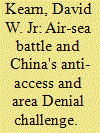| Srl | Item |
| 1 |
ID:
143285


|
|
|
|
|
| Summary/Abstract |
In response to China’s military modernization and growing anti-access/area denial capabilities, the US military has adopted an “Air Sea Battle” (ASB) concept entailing extensive strikes on the Chinese mainland. ASB has been embraced at the Pentagon and increasingly affects procurement decisions. Critics argue that ASB creates grave escalation risks and may incite an expensive arms race. Less discussed, but also of serious concern, is that ASB was adopted with little to no civilian oversight, in a case of “structural inattention.” This failure of civil–military relations derives from institutional factors such as the nature and composition of the White House staff, as well as from the administration’s pragmatic rather than strategic approach to China. It has also been facilitated by “subterranean factors” including the interests of influential military contractors and the military’s own inclination toward conventional warfare.
|
|
|
|
|
|
|
|
|
|
|
|
|
|
|
|
| 2 |
ID:
126774


|
|
|
|
|
| Publication |
2013.
|
| Summary/Abstract |
The challenge presented by china's military modernization has seemingly altered the conventional balance in the western pacific, with significant implications for U.S. national security policy, and, thus, deserves the focus of planners and decision-makers.
|
|
|
|
|
|
|
|
|
|
|
|
|
|
|
|
| 3 |
ID:
112744


|
|
|
|
|
| Publication |
2012.
|
| Summary/Abstract |
This article surveys some of the challenges that President Obama or his successor
will face over the next several years as the United States attempts to "pivot
toward Asia." In view of the ongoing shift in power from West to East, Washington
can no longer assume that it can preserve or transform Asia-Pacific security by its
unilateral actions. Rather, the United States must develop a "lead from behind"
strategy that will assist America's Asia-Pacific friends and allies to "make room
for China" while at the same time encouraging them to take greater responsibility
for regional security. As it develops its plans for the Asia-Pacific region, the
United States will have to accord special attention to three legacy issues (the
China-Taiwan relationship, the unresolved confrontation between North and
South Korea, and the incompatibility of American and Chinese values) which
have confounded U.S.-China relations for six decades. If managed properly, a
U.S. pivot toward Asia can be beneficial to both the United States and America's
regional friends and allies. But this will require Washington to pursue what President
Obama recently described as a "more centered course" that leverages America's
assets in the Asia-Pacific while avoiding policies that force regional governments
to choose between Washington and Beijing.
|
|
|
|
|
|
|
|
|
|
|
|
|
|
|
|